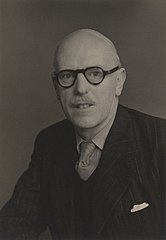T. D. Kendrick
FSA | |
|---|---|
 | |
| Born | 1 April 1895 |
| Died | 2 November 1979 (aged 84) |
| Nationality | English |
| Education | Oriel College, Oxford |
| Occupation(s) | Director and Principal Librarian of the British Museum (1950–1959) |
| Notable work | A History of the Vikings (1930) |
| Spouses |
|
| Children | Frances Kendrick Sally Maud Senior |
| Parents |
|
| Relatives | William Kendrick (brother) |
| Awards | Knight Commander of the Bath |
Sir Thomas Downing Kendrick
Life
Early life
Kendrick was born on 1 April 1895[3] in Handsworth, a suburb of Birmingham, England,[4] to Fanny Susan (nee Downing, born 1865)[5] and Thomas H. Kendrick (1867–1902).[6] He had a younger brother, William (born 1899).[3] Following his father's death his mother married Prebendary Sowter in 1905.[4]
He was educated at Charterhouse School and then spent a year at Oriel College, Oxford, prior to the outbreak of World War I.[4] He joined the Royal Warwickshire Regiment in 1914. During which he was wounded in France and rose to the rank of captain. Resuming his studies at Oxford in 1918, he graduated in 1919 with a degree in anthropology and in 1920 with a Master of Arts also in anthropology.[4] Kendrick stayed at Oxford and commenced a Bachelor of Science investigating the megaliths of the Channel Islands.
Career
His research experience enabled him to secure a position in 1922 as an assistant in the British and Medieval Antiquities Department of the British Museum.[4]
Initially specializing in prehistoric art, Kendrick turned in the 1930s to Viking and Anglo-Saxon art, for which his two survey volumes were long standard references. He was appointed an assistant keeper at the British Museum in 1928. He coined the term "henge" in 1932 to describe a series of ceremonial monuments defined by ditches and banks of soil rather than standing stones.[7][8][9] He was subsequently made keeper of the British and Medieval Antiquities Department in 1938.[4]
In 1950 Kendrick was made director and principal librarian of the British Museum and remained in that position until he retired in 1959.[4] He believed in cleaning museum objects, but this resulted in numerous bronze artifacts in his department being overcleaned.[4]
He was a keen advocate of Victorian art, with assistance from the poet John Betjeman and the painter John Piper, amongst others. Kendrick's notes on Victorian stained glass were used by Nikolaus Pevsner for his Buildings of England series (now the Pevsner Architectural Guides).[10]
He was honoured with the award of a Knight Commander of the Bath in 1951.
Kendrick died on 2 November 1979 in Dorchester.[4]
Personal life
In 1922, Kendrick married the pianist Ellen Martha Kiek (1898–1955), whom he had met at university.[4] They had one daughter, Frances. Following Helen's death in 1955, Kendrick married Katherine Elizabeth Wrigley (1903–1980), a friend of the family.[11][4]
Beginning in the late 1930 he had a six-year affair with
During the early 1950s Kendrick had a relationship with the novelist Barbara Pym, who had been a friend of his daughter in the WRNS during the war.[14]
Publications
Books
- The Axe Age: a study in British prehistory (1925)
- The Druids: a study in Keltic prehistory (1927)
- A History of the Vikings (London: Methuen, 1930).
- Anglo-Saxon Artto A.D. 900 (1938)
- The Archaeology of the Channel Islands, 2 vols. (1928–38)
- Archaeology in England and Wales, 1914–1931 (1932)
- The Presidents of the Society of Antiquaries of London: with biographical notes (1945) (with Sir James Mann)
- Late Saxon and Viking art (1949)
- British Antiquity (1950)
- The Lisbon Earthquake (1956)
- St. James in Spain (1960)
- Great Love for Icarus (1962) – a semi-autobiographical novel
- Mary of Agreda: the life and legend of a Spanish nun (1967)
Articles
- Kendrick, T. D. (June 1932). "British Hanging Bowls". Antiquity. 6 (22): 161–184. S2CID 163210163.

- Kendrick, T. D. (January 1941). "Notes: Portion of a basalt hone from North Wales". Antiquaries Journal. 21 (1): 73. .
- Kendrick, T. D. (January 1941). "Notes: Gourd bottles from Sutton Hoo". Antiquaries Journal. 21 (1): 73–74. .
- Kendrick, T. D. (January 1941). "Notes: Dug-out canoes in the British Museum". Antiquaries Journal. 21 (1): 74–75. .
- Kendrick, T. D. (January 1941). "Notes: Fragment of a cross-head from Bath". Antiquaries Journal. 21 (1): 75–76. .
References
- ^ Wilson 2005.
- ^ The Times 1979, p. 31.
- ^ a b "Sir Thomas Downing Kendrick". Family Search. 15 November 2017. Retrieved 7 August 2022.
- ^ a b c d e f g h i j k Sorensen, Lee (ed.). "Kendrick, T. D." Dictionary of Art Historians. Retrieved 7 July 2022.
- ^ "Fanny Susan Downing". Family Search. 16 November 2017. Retrieved 7 August 2022.
- ^ "Thomas H Kendrick". Family Search. 16 November 2017. Retrieved 7 August 2022.
- ^ Rothwell, Henry. "Henges – or the archaeology of etymology (or vice versa); The man who gave us the word". Digital digging. Retrieved 4 September 2009.
- ^ Pitts, Michael (2011). Hengeworld. Random House. pp. 26–28.
Stonehenge is not a henge. This bizarre contribution … was first used by … Thomas Kendrick. … Technically, [henges] are earthwork enclosures in which a ditch was dug to make a bank, which was thrown up on the outside edge of the ditch.
- ISBN 978 07141 2349 3.
- ^ Nikolaus Pevsner, The Buildings of England: Cornwall (1951), p. 9.
- ISBN 978-0-19-726277-1.
- ^ S2CID 163617981.
- ^ ISBN 978-1-529-38743-8.
- ISBN 9780008322205.
Sources
- ISSN 0068-1202.

- doi:10.1093/ref:odnb/31303. (Subscription or UK public library membershiprequired.)
- "Sir Thomas Kendrick". The Times. 23 November 1979. p. 31.
Further reading
- "Kendrick, Sir Thomas Downing". ISBN 978-0-19-954089-1. Retrieved 5 March 2020.
